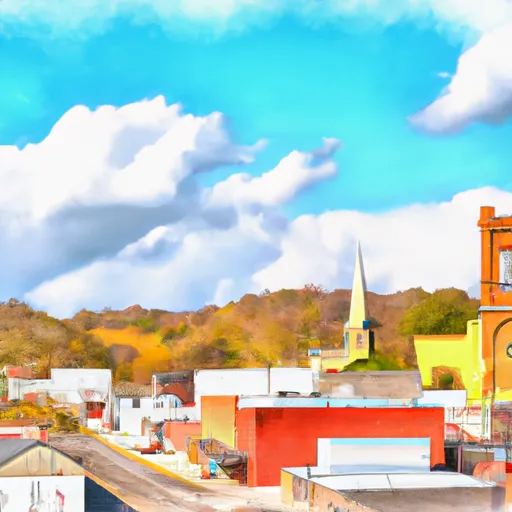-
 Snoflo Premium
Snoflo Premium
Get unlimited access to all our content
With no Ad interruptions! - Start Your Free Trial Login with existing account
Jeremiah
Eden Index
Climate
8.3
•
Recreation
3.4
•
Community
0.9
•
Safeguard
4.7/10

Jeremiah, Kentucky is a small town located in Letcher County, in the southeastern part of the state. The climate in Jeremiah can be described as humid subtropical, with hot and humid summers and mild winters. Summers are characterized by temperatures reaching the mid-80s (Fahrenheit) and occasional rainfall, while winters see temperatures averaging in the low 40s.
The hydrology constituents in Jeremiah are primarily influenced by the nearby Kentucky River, which plays a significant role in the town's water sources and recreational activities. Other water bodies in the area include creeks and small lakes that provide opportunities for fishing, boating, and swimming.
Outdoor recreation opportunities in Jeremiah are abundant. The town is surrounded by the picturesque Appalachian Mountains, offering a range of activities such as hiking, camping, and wildlife watching. The nearby Bad Branch Falls State Nature Preserve is a popular spot for hiking, with its beautiful waterfalls and diverse flora and fauna. Additionally, the Kingdom Come State Park is located nearby, providing opportunities for camping, fishing, and enjoying scenic views.
Overall, Jeremiah, Kentucky offers a pleasant climate, various hydrology constituents, and ample outdoor recreation opportunities for locals and visitors alike.
What is the Eden Index?
The Snoflo Eden Index serves as a comprehensive rating system for regions, evaluating their desirability through a holistic assessment of climate health, outdoor recreation opportunities, and natural disaster risk, acknowledging the profound impact of these factors on livability and well-being.
Climate Health Indicator (CHI): 8.3
Jeremiah receives approximately
1109mm of rain per year,
with humidity levels near 81%
and air temperatures averaging around
13°C.
Jeremiah has a plant hardyness factor of
6, meaning
plants and agriculture in this region thrive during a short period during spring and early summer. Most
plants will die off during the colder winter months.
By considering the ideal temperature range, reliable water supplies, clean air, and stable seasonal rain or snowpacks, the Climate Health Indicator (CHI) underscores the significance of a healthy climate as the foundation for quality living.
A healthy climate is paramount for ensuring a high quality of life and livability in a region, fostering both physical well-being and environmental harmony. This can be characterized by ideal temperatures, reliable access to water supplies, clean air, and consistent seasonal rain or snowpacks.
Weather Forecast
Streamflow Conditions
Kentucky
Area Rivers
Kentucky
Snowpack Depths
Kentucky
Reservoir Storage Capacity
Kentucky
Groundwater Levels
Recreational Opportunity Index (ROI): 3.4
The Recreational Opportunity Index (ROI) recognizes the value of outdoor recreational options, such as parks, hiking trails, camping sites, and fishing spots, while acknowledging that climate plays a pivotal role in ensuring the comfort and consistency of these experiences.
Access to outdoor recreational opportunities, encompassing activities such as parks, hiking, camping, and fishing, is crucial for overall well-being, and the climate plays a pivotal role in enabling and enhancing these experiences, ensuring that individuals can engage in nature-based activities comfortably and consistently.
Camping Areas
| Campground | Campsites | Reservations | Toilets | Showers | Elevation |
|---|---|---|---|---|---|
| Natural Tunnel State Park | None | 1,703 ft | |||
| Houston Valley | None | 1,843 ft | |||
| Cataloochee - Great Smoky Mountains | 27 | 2,652 ft | |||
| Mount Pisgah - Blue Ridge Parkway | None | 4,859 ft | |||
| Big Creek - Great Smoky Mountains | 12 | 1,701 ft | |||
| Portal 31 RV Park | 20 | 1,841 ft | |||
| Rocky Bluff | 30 | 1,753 ft | |||
| Paint Creek | 21 | 1,750 ft | |||
| Carr Creek State Park | 40 | 1,093 ft | |||
| Kinser Park | None | 1,314 ft |
Nearby Ski Areas
Catastrophe Safeguard Index (CSI):
The Catastrophe Safeguard Index (CSI) recognizes that natural disaster risk, encompassing floods, fires, hurricanes, and tornadoes, can drastically affect safety and the overall appeal of an area.
The level of natural disaster risk in a region significantly affects safety and the overall livability, with climate change amplifying these risks by potentially increasing the frequency and intensity of events like floods, fires, hurricanes, and tornadoes, thereby posing substantial challenges to community resilience and well-being.
Community Resilience Indicator (CRI): 0.9
The Community Resilience Indicator (CRI) recognizes that education, healthcare, and socioeconomics are crucial to the well-being of a region. The CRI acknowledges the profound impact of these elements on residents' overall quality of life. By evaluating educational resources, healthcare accessibility, and economic inclusivity, the index captures the essential aspects that contribute to a thriving community, fostering resident satisfaction, equity, and social cohesion.

